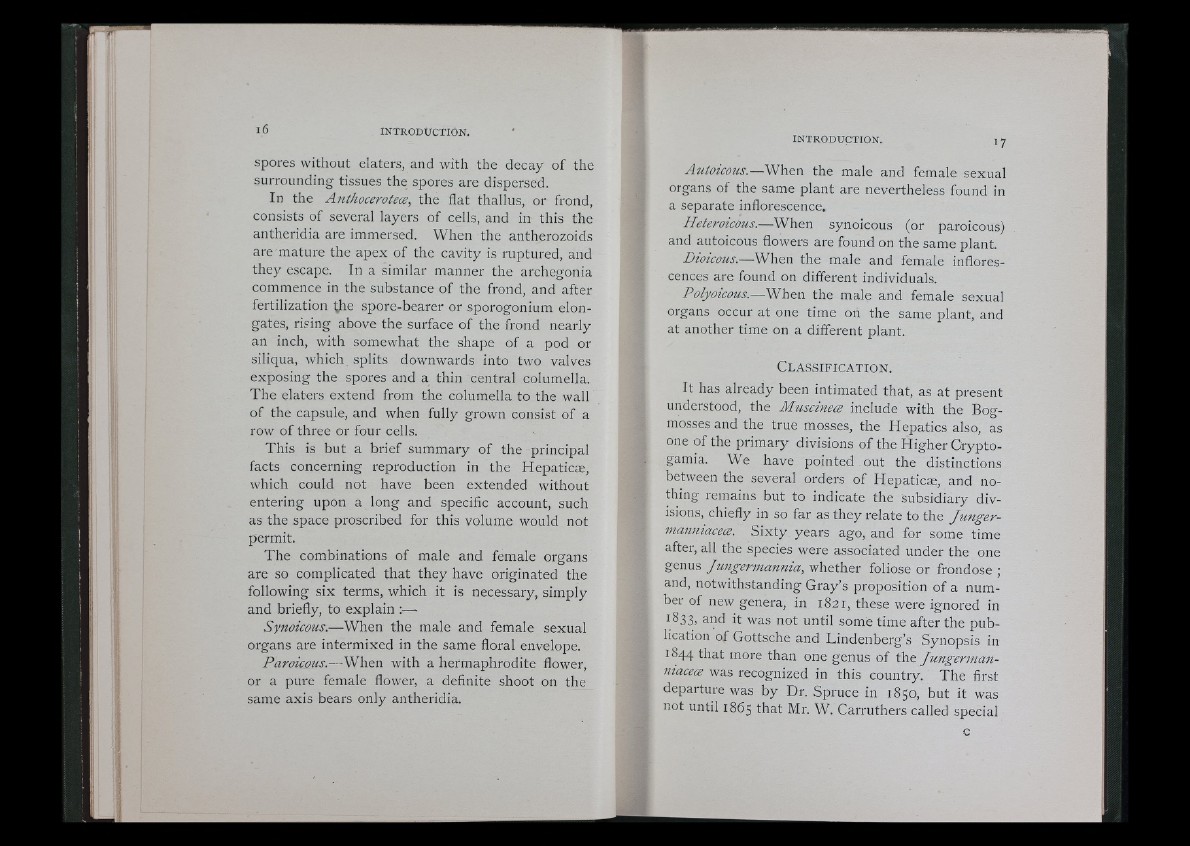
spores without elaters, and with the decay of the
surrounding tissues the spores are dispersed.
In the Anthoceroteæ, the flat thallus, or frond,
consists of several layers of cells, and in this the
antheridia are immersed. When the antherozoids
are mature the apex of the cavity is ruptured, and
they escape. In a similar manner the archegonia
commence in the substance of the frond, and after
fertilization the spore-bearer or sporogonium elongates,
rising above the surface of the frond nearly
an inch, with somewhat the shape of a pod or
siliqua, which, splits downwards into two valves
exposing the spores and a thin central columella.
The elaters extend from the columella to the wall
of the capsule, and when fully grown consist of a
row of three or four cells.
This is but a brief summary of the principal
facts concerning reproduction in the Hepaticæ,
which could not have been extended without
entering upon a long and specific account, such
as the space proscribed for this volume would not
permit.
The combinations of male and female organs
are so complicated that they have originated the
following six terms, which it is necessary, simply
and briefly, to explain :—
Synoicous.— When the male and female sexual
organs are intermixed in the same floral envelope.
Paroicous.— When with a hermaphrodite flower,
or a pure female flower, a definite shoot on the
same axis bears only antheridia.
INTRODUCTION. 17
Atitokous.— When the male and female sexual
organs of the same plant are nevertheless found in
a separate inflorescence.
Heteroicous.— When synoicous (or paroicous)
and autoicous flowers are found on the same plant.
Dioicous.— When the male and female inflorescences
are found on different individuals.
Polyoicous.— When the male and female sexual
organs occur at one time on the same plant, and
at another time on a different plant.
CLA.SSIFICATION.
It has already been intimated that, as at present
understood, the MuscinecB include with the Bog-
mosses and the true mosses, the Hepatics also, as
one of the primary divisions of the Higher Cryptogamia.
We have pointed out the distinctions
between the several orders of Hepáticas, and nothing
remains but to indicate the subsidiary divisions,
chiefly in so far as they relate to the JungermanniacecB.
Sixty years ago, and for some time
after, all the species were associated under the one
genus Jungermannia, whether foliose or frondose ;
and, notwithstanding Gray’s proposition of a number
of new genera, in 1821, these were ignored in
1^33) 3-i)d it was not until some time after the publication
of Gottsche and Lindenberg’s Synopsis in
1844 that more than one genus of the JungermanniacecB
was recognized in this country. The first
departure was by Dr. Spruce in 1850, but it was
not until 1865 that Mr. "W. Carruthers called special